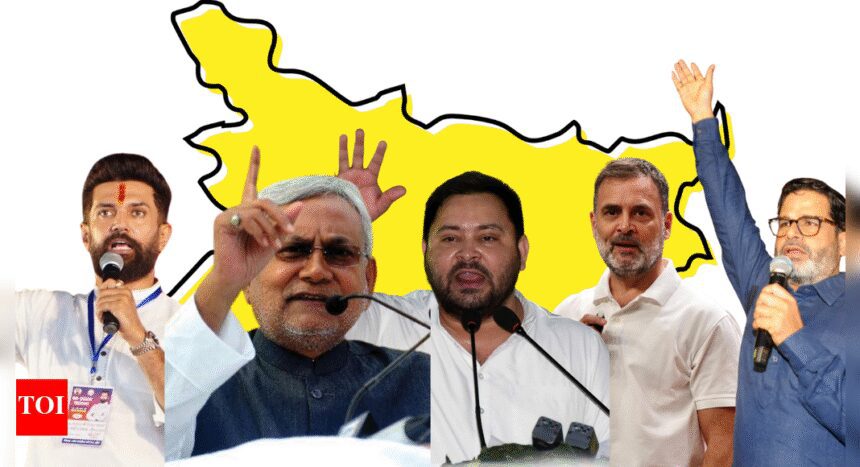NEW DELHI: The countdown to the Bihar Assembly elections has officially begun, with the Election Commission announcing that the polls will take place in two phases on November 6 and November 11. The results are slated for release on November 14. Political parties in Bihar are already intensifying their campaigns in anticipation of the significant electoral contest.
This election presents critical stakes for the key players in the state’s political landscape.
Nitish Kumar
Incumbent Chief Minister Nitish Kumar faces a pivotal moment in the 2025 Bihar Assembly elections that will define his personal legacy and the relevance of his party. This will be his eighth consecutive bid for the chief ministerial position after two decades in power, marked by governance reforms and social welfare initiatives, alongside notable political alliances that have earned him the label ‘Paltu Ram.’ As voters assess his reputation as the ‘Vikas Purush’ (development man), they will consider whether his perceived stability and credibility in law and order have eroded due to political fatigue and policy stagnation. Kumar’s age (74) has also prompted discussions around his capability to govern effectively, an issue raised by opposition leaders. The results will determine not only his political future but also the survival of the Janata Dal (United) as a prominent force, weighing against the influence of its ally, the BJP.
Tejashwi Yadav
For Tejashwi Yadav, son of Lalu Yadav and former Deputy Chief Minister, the upcoming elections represent a critical test of his leadership and the prospects of the Rashtriya Janata Dal (RJD). Following the RJD’s performance in the 2020 elections, where it became the single-largest party in the state with 75 seats, expectations are high for Yadav as he seeks to secure the Chief Minister role. The Mahagathbandhan (Grand Alliance) narrowly lost to the NDA by just 0.03%, equating to approximately 12,768 votes out of around 3.14 crore. As coalition dynamics play a crucial role, Yadav must address the aspirations of diverse voter demographics, particularly the youth and non-Yadav OBCs, while challenging the NDA’s political machinery.
Rahul Gandhi
For Rahul Gandhi, this election is an essential test of his national leadership and the potential revival of the Congress party within the INDIA bloc. His recent losses in states like Maharashtra, Haryana, and Delhi heighten the pressure to achieve tangible gains in Bihar. Gandhi’s involvement, including the ‘Voter Adhikar Yatra’ and the creation of the ‘Atipichhda Nyay Sankalp’ manifesto for the EBCs, highlights his commitment to driving the campaign. The results will reveal whether he can transform high-profile outreach into electoral success or if the JD(U)-BJP and RJD will continue to dominate Bihar’s politics. This election will also gauge Congress’s organizational capabilities on the ground, testing Gandhi’s ability to connect with a critical voter base in the Hindi heartland.
Chirag Paswan
Chirag Paswan’s past successes in Bihar have been noteworthy yet relatively shallow in real influence. Although he won six Lok Sabha seats in both 2014 and 2019, translating that national recognition into state-level authority remains a challenge. The upcoming election will determine if his Lok Janshakti Party (LJP) can transition from being a junior player to a significant regional force in Bihar. Success could shift the party’s leverage in coalition negotiations and governance, while failure might echo the previous results of 2020.
Prashant Kishor
Prashant Kishor enters the electoral fray with his Jan Suraaj Party (JSP), making his political debut as he attempts to disrupt entrenched caste-based politics in Bihar. His decision to contest all 243 assembly seats independently marks a clear refusal to align with established parties, positioning JSP as a radical alternative to both JD(U)-BJP and RJD-Congress. Kishor has claimed that his party will either secure the top position or finish last, leaving no middle ground. This election poses both a risk and opportunity, with the outcome poised to define his future as a political leader and the longevity of Jan Suraaj in Bihar’s political landscape.










